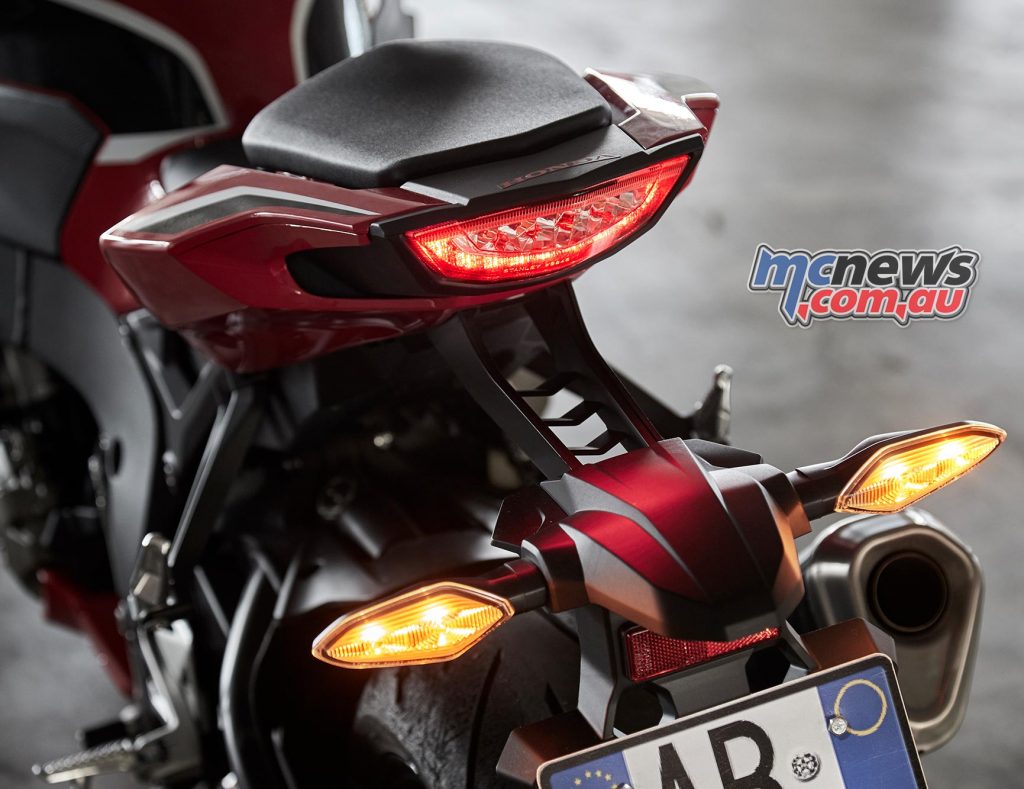2017 Honda CBR1000RR Fireblade Reviewed at Phillip Island
By Mark Willis – Images by Robert Murdoch / Honda
The glorious layout of the Phillip Island Grand Prix circuit played host to the national press launch of the all new welcome to the digital age Honda CBR1000RR Fireblade. This model marks the 25th anniversary of original CBR900RR, and is the first major overhaul to the current 1000cc capacity blade this decade, so it will be interesting to see how the Honda has evolved in the litre sports bike class.
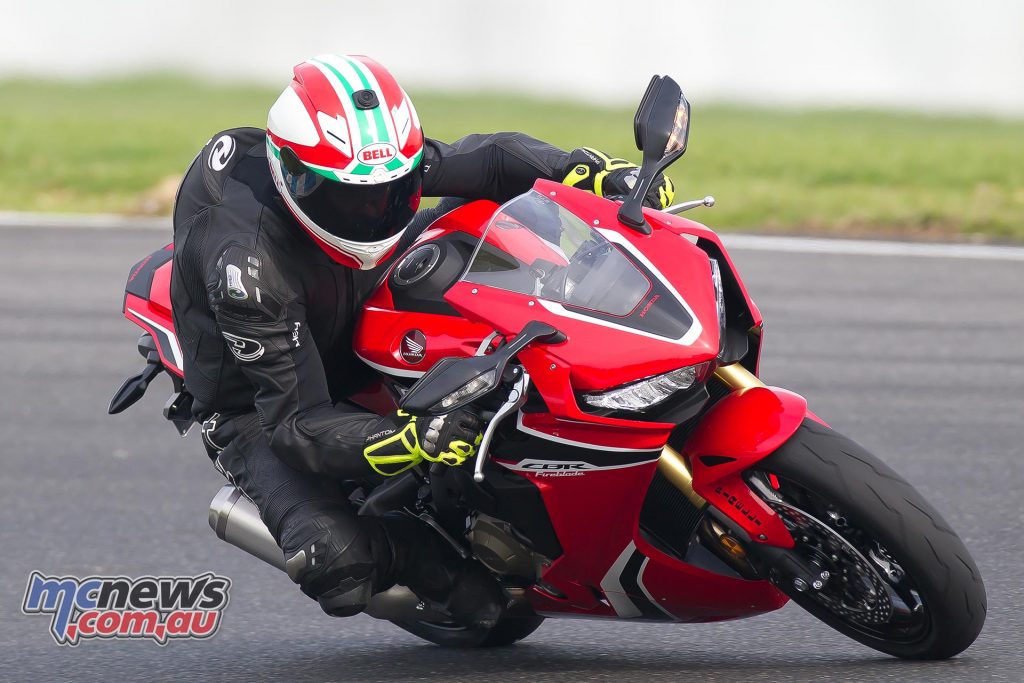
The competition is fierce in this category with the Euro brands leading the way in development over the past five years. Add to this a new Suzuki GSX-R1000 that is about to land on showroom floors, and a re-invigorated YZF-R1 from Yamaha landing last year, and Honda definitely needs to bring their A game to this fight.
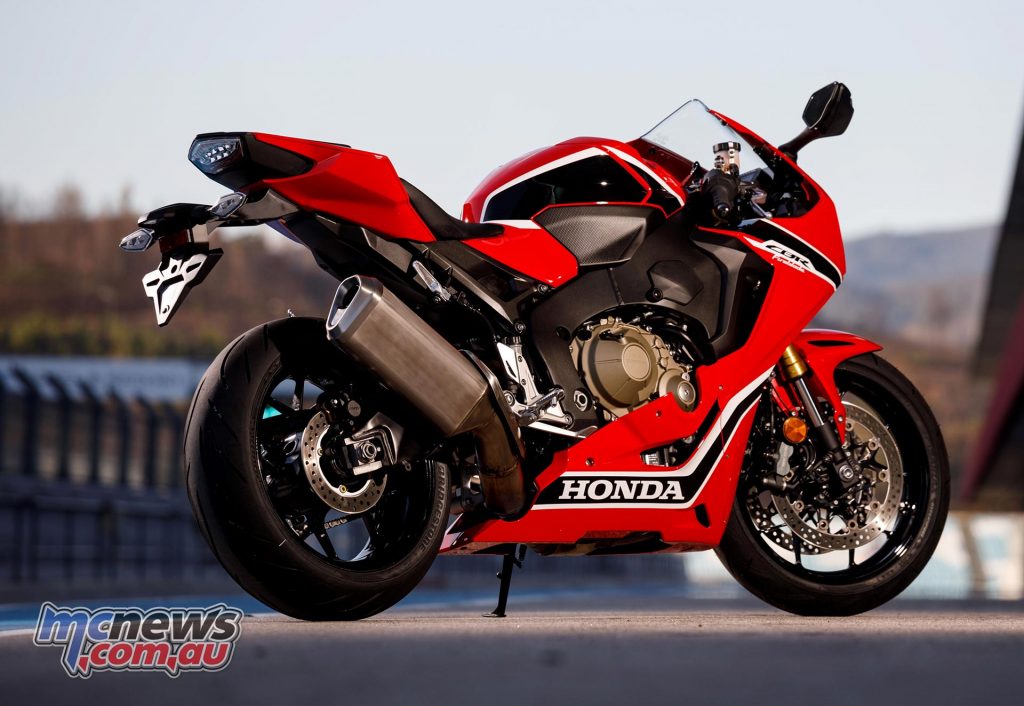
As new models are released, and we see new generations of bikes come through, I am constantly amazed at how good the bikes are straight out of the box. It wasn’t that long ago that to take a standard street bike racing was an arduous and hideously expensive task.
The Fireblades we rode at Phillip island were quite literally straight out of the box. No special set-up sessions with experts before we jumped on the bikes, but delivered just as a punter would roll out of his local Honda showroom on after laying down their hard earned and riding away on their new prize. Apart from the sticky Pirelli Supercorsa rubber that is.
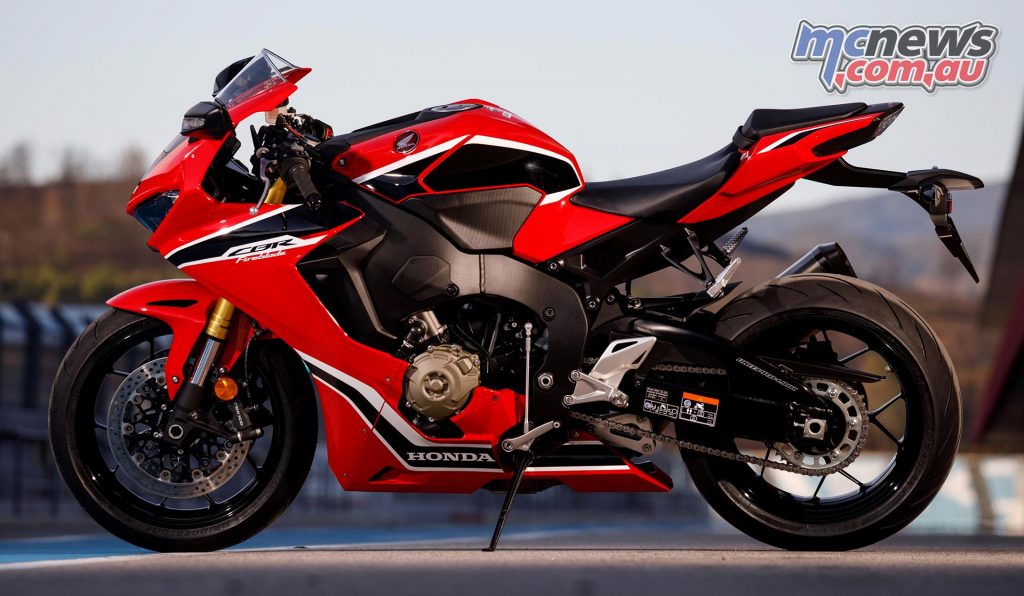
Honda’s design brief for the new Fireblade was broken into three categories. More power, less weight and a substantial electronics package to further aid the overall rider experience.
In the engine department, Honda is claiming a lot more grunt. A significant increase of 14 per cent in the power-to-weight ratio compared to the previous model. The compression has been lifted from 12:3;1 to 13:1, new pistons feature a modified crown design and DLC coated rings help with sealing.
Revised cam timing and a cylinder head that features polished inlet and exhaust ports all add up for an engine that revs harder and higher. The new red line set at 13,000rpm, a number that Honda has not ventured before in this litrebike category.
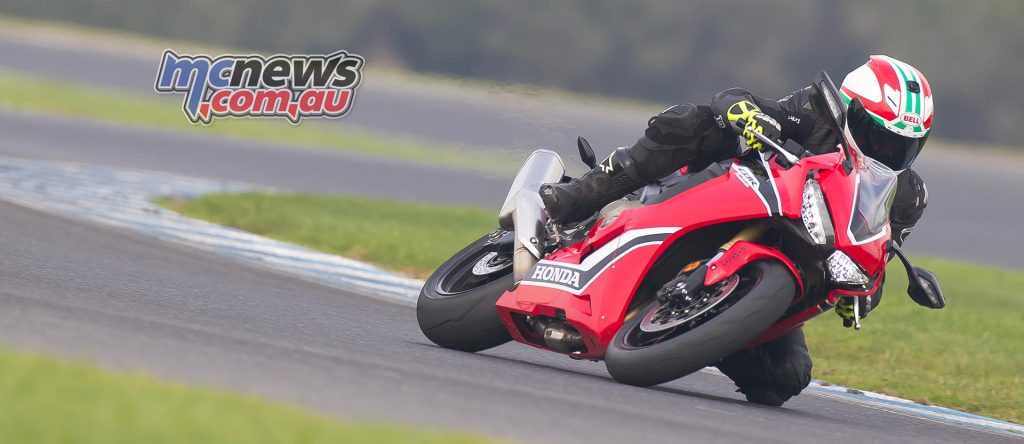
Honda has always built a good engine and this new model Blade is no exception. I still have stirring memories of being able to throw my leg over an original Honda CBR900 in early 1993, as a 16-year-old, that pure sense of speed and exhilaration still lingers now. At that point in my life it was by far the fastest and quickest accelerating machine on two or four wheels I had experienced.
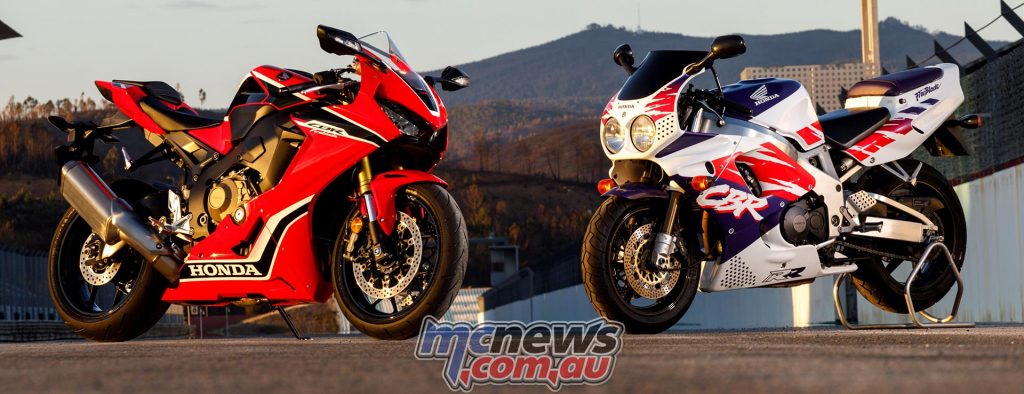
The increase in horsepower to the new Fireblade engine is welcomed and much needed, the previous generation engine was getting a little long in the tooth.. Powerplants from rival manufacturers crawling ahead in the horsepower stakes in recent times.
The increased rev-limit on the new model is a noticeable feature. The engine now pulls strongly all the way to above 13,000rpm, over 1000rpm more than the old model. As with most manufacturers, the standard gearing is too high (we were hitting 300km/h at the end of the straight in 5th!), so being able to hold a gear for longer on the exit of turns or down the straight without being punished is a key advantage.
I was also impressed at how strong the engine is in that last 3000rpm of the rev range. While the torque has increased a little in the new engine, it’s the peak horsepower that has been given the new Fireblade the biggest boost.
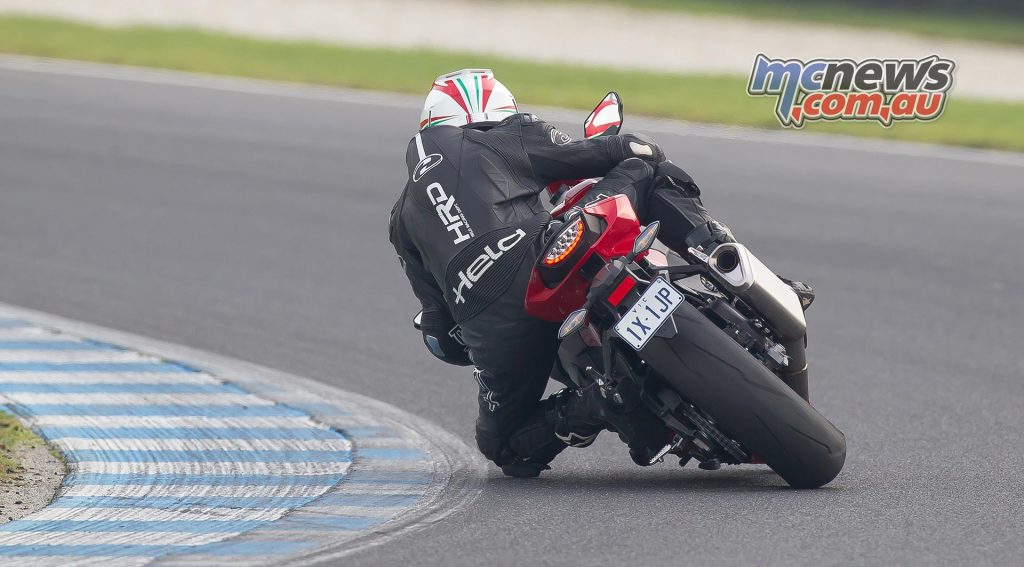
I think the new spec’ GSX-R1000 engine from Suzuki that we tested here has a small advantage in the torque stakes, and its drivability from low in the rpm, but the new Blade comes into its own from 9000rpm, and feels perhaps a little stronger up top.
Weight reduction was a key focus for the engineers at Honda and they have been able to shave a whopping 15kg off the previous generation ABS model. 90 per cent of the main components have been changed in search of incremental weight reductions in all areas. This is quite remarkable, as I certainly didn’t think the older Blade felt heavy at all!
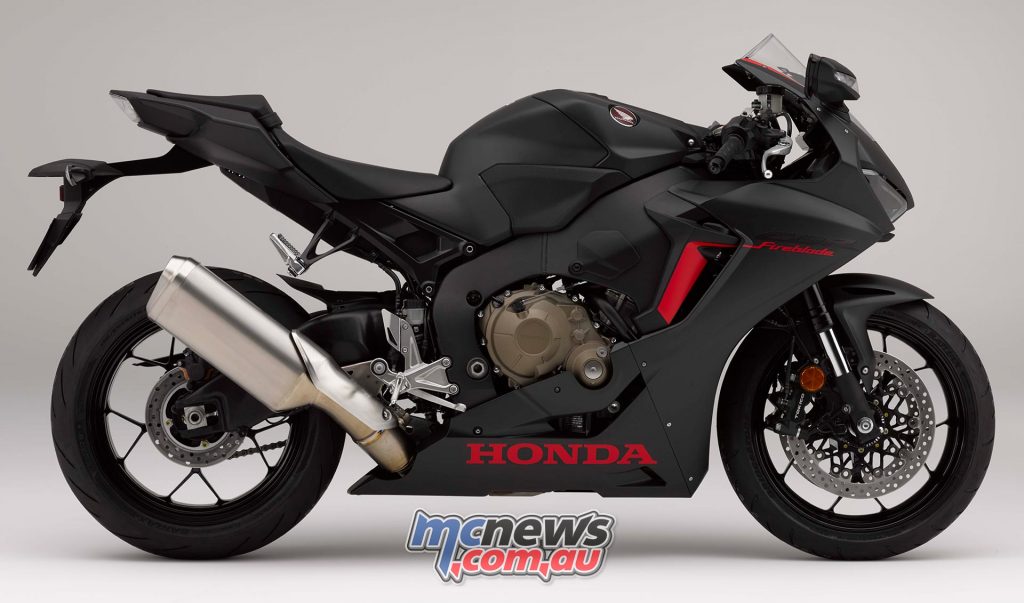
There has been no part of the motorcycle spared when it came to the diet but the notable reductions in engine weight have been achieved through the use of magnesium for the sump and ignition covers. The gearbox also features lighter but stronger transmission gears. The exhaust gases are released through a new MotoGP developed titanium four-into-two-into-one exhaust with integrated exhaust valve. The weight saving of the exhaust alone is just under 2.5kg.
Up until the release last year of the new Yamaha R1, and the pending arrival of the all new Suzuki GSX-R1000, the Japanese manufacturers have been playing catch up in the electronics stakes. Ducati, Aprilla and BMW have all equipped their litre class sports bikes with elaborate electronics packages, which give the everyday rider, and serious competitor, a range of useful accommodating rider aids.
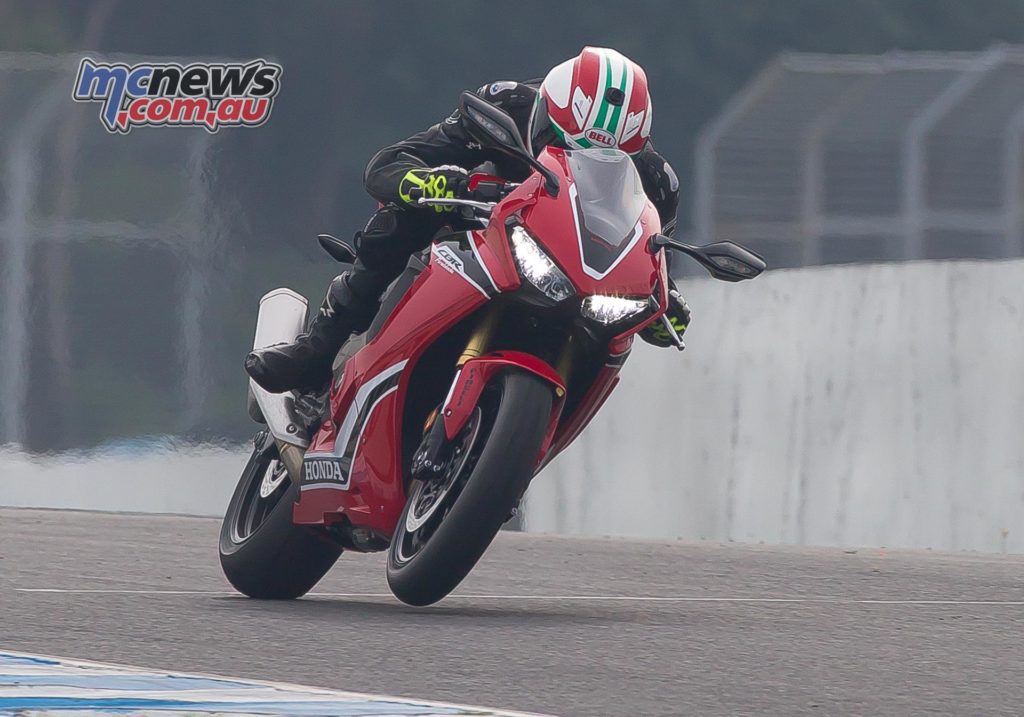
Honda has made a serious effort to bridge that gap with the new generation Fireblade. The CBR1000RR’s new cutting-edge electronics package allows the pilot to personalise the bike’s performance to their own needs. The new system is equipped with a five-axis Inertial Measurement Unit (IMU) gyro, which precisely measures what the machine is doing every 10ms through every plane.
It works in conjunction with the fuel-injection ECU, and the all new Throttle by Wire system – the first on an in-line-four Honda. The ABS consists of new small and compact modulators, and front and rear wheel speed sensors which talk to the IMU.
Along with the quite normal feature in these packages, such as anti-wheelie control, the new Fireblade also incorporates rear lift control. This is to help keep the rear wheel on the ground under heavy braking, hence allowing more control under extreme braking for a smoother entry into the corner. One interesting difference with the Honda electronics package is the inability to fully disengage the ABS.
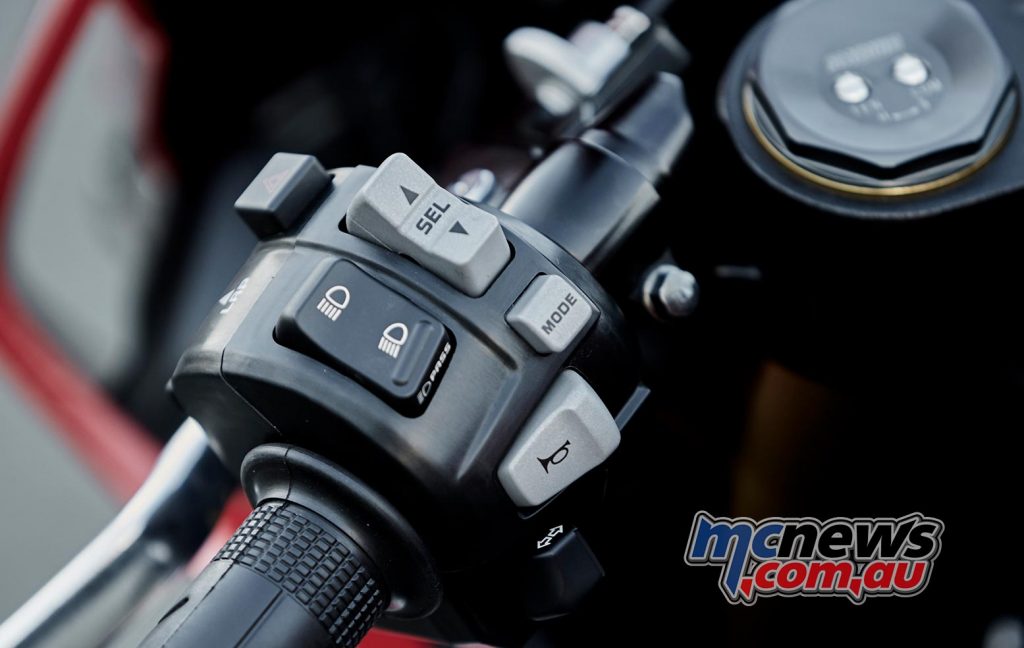
Rider modes are very user friendly with three pre-set options and a further two settings that can be programmed and saved to the rider’s preference. These are then easy to navigate, on the fly, via the control unit on the left switchblock. The rider modes are broken into three categories.
Power Modes offer five levels. These regulate engine power to varying degrees from peak output in all six gears. All levels have the same throttle response on initial opening.
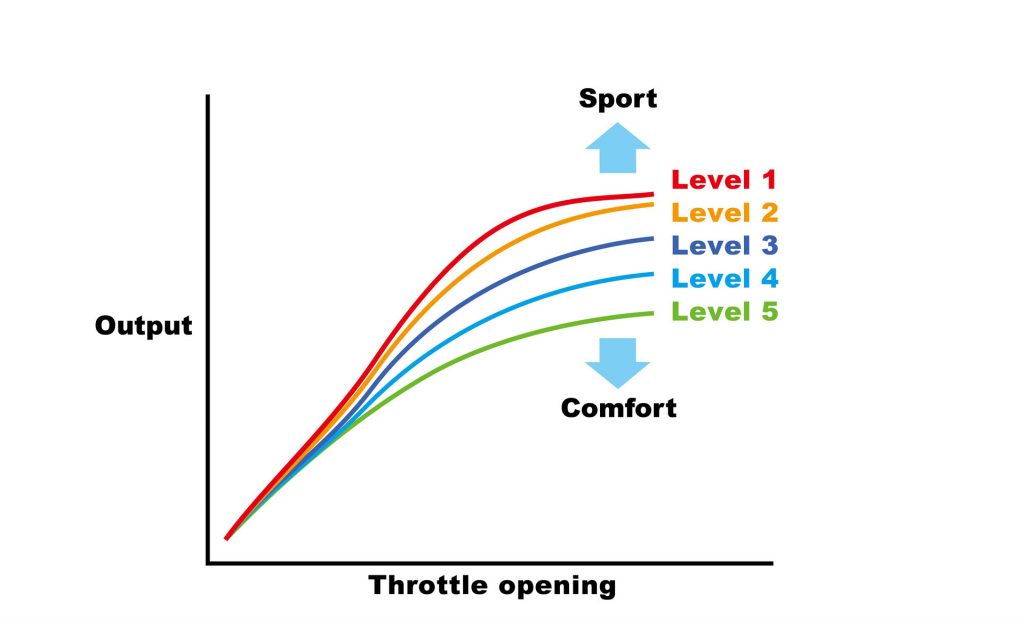
Torque Control (or what most manufacturers refer to as Traction Control), has nine levels, and the ability to be switched off completely. Level 1 provides minimal intervention, through to a severe anti-spin setting of 9.
Engine Brake Control offers three settings and this regulates the amount of engine-braking force when you roll off the throttle. 1 being maximum engine breaking, through 3 which offers the least compression.
The graph below shows the parameters a little clearer.
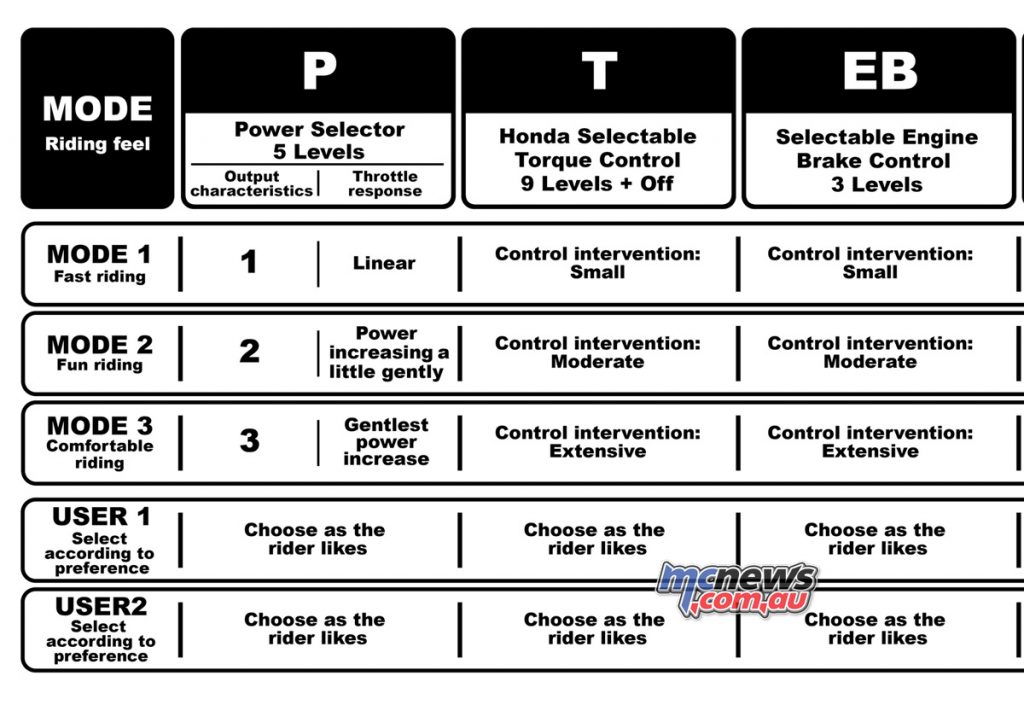
So how does all that feel on the track? Interestingly Honda’s first attempt at mass produced fly-by-wire sports bike has me feeling it still needs a little refinement. The throttle action is nice, sitting on the bike parked you would be excused for thinking that there were cables attached, but out on track I found the connection from off to on a little snatchy, when picking up the gas from a closed throttle.
This gave me flashbacks of early fuel-injected race bikes where getting smooth throttle application was quite hard work. I experienced this from low in the rpm driving out of Turn 4 in second gear, the tacho not showing much more than 6000rpm. The hayshed, a fast third gear right hander over the back of the circuit, where the tacho was between 9000-10,000rpm, was also another small glitch for me. No doubt the system will benefit down the track from any software improvements via simple download at your local Honda dealer.
As the day progressed I got used to this, and in the majority of situations, especially on the road, riders wouldn’t notice. However, for a racer, or ex-racer as is my now hasbeen case, that connection you feel between throttle and engine is one of the key things we are chasing for smooth corner exits.
(Editors’s Note – Mark is far from your average punter, a few years surviving the worst 500cc two-strokes on the Grand Prix circuit, while also taking wins at Bol d’Or and Spa 24 Hour Superbikes races, means he is a little bit special, in many ways…).
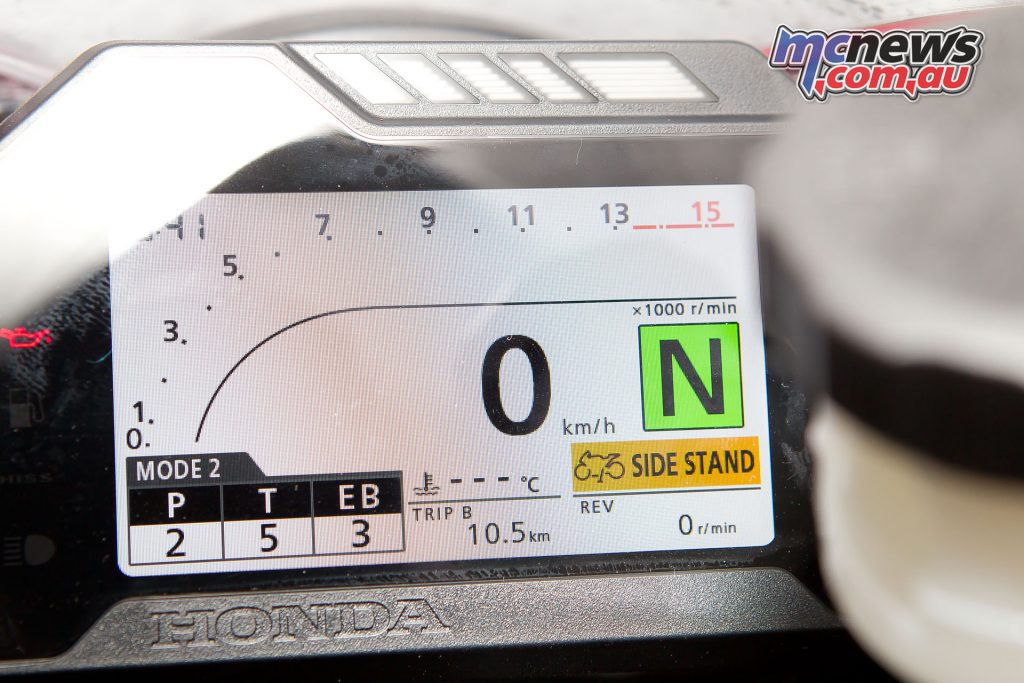
The electronics package is remarkably simple to navigate and use. I had no trouble in finding a setting that worked for me. I spent quite some time fiddling through all the modes trying a vast array of different combinations. I used the power in levels 1-3 but obviously at Phillip Island, on a dry track, I was not going to waste valuable track time with anything but full power!
The torque or traction control setting I played with quite extensively on each outing. I only really found that the least invasive levels were needed with the track conditions as they were, but it’s nice to know you have the option to ramp those settings up if there was a change in adhesion levels.
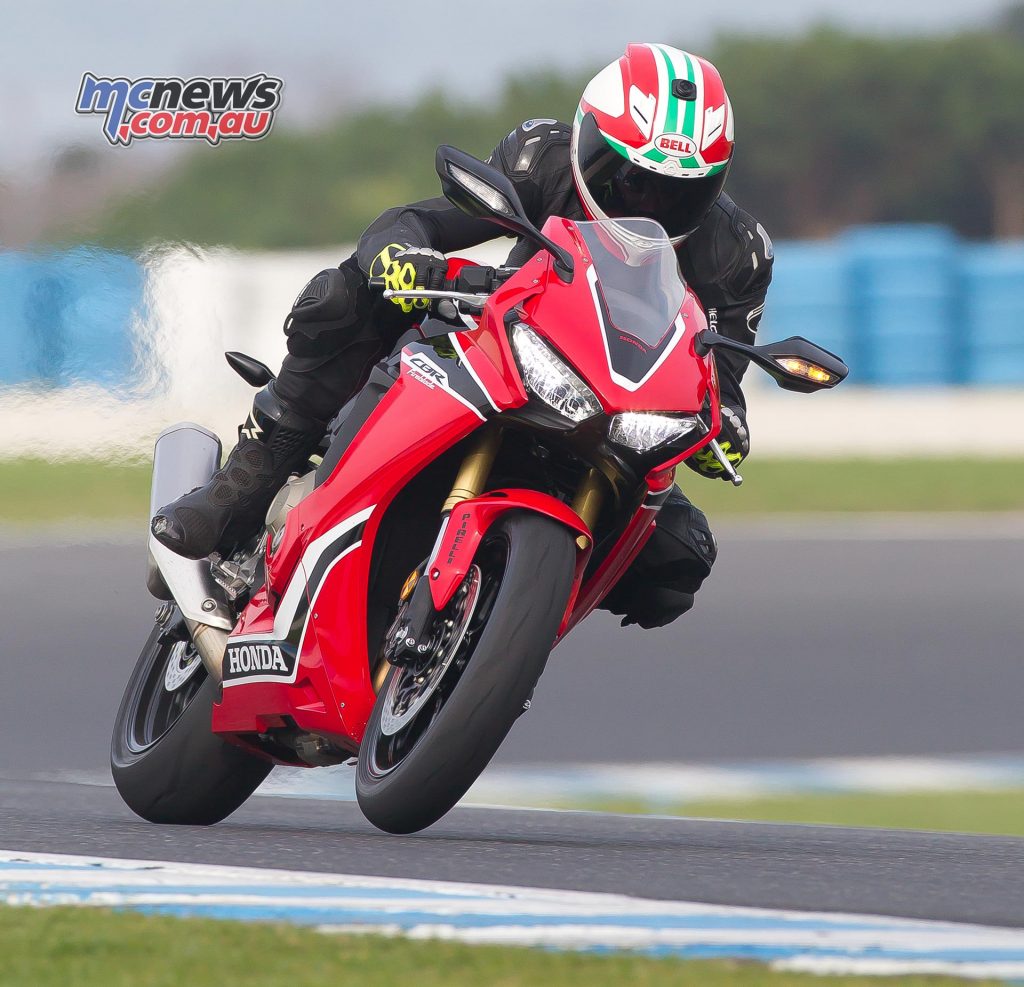
I ended up switching it off all together for the last four sessions for no other reason than I find it more fun! There is something about spinning a bike in fourth gear through turn 12 that just pushes my buttons. Overall Honda has done an exceptional job on the electronics side.
Current ASBK Champion Troy Herfoss was somewhat alarmed when he followed Mark through turn 11 early in the first session. He came back into the pits laughing at the amount of smoke ‘Willow’ had pouring off that rear Pirelli. So much for easing into it!
Even with the torque setting on anything up to 5, the electronics still allow you to drift the rear. It is not an invasive feeling when it does start to peg back the wheelspin, it happens quite smoothly and progressively. Considering the power to weight ratio that modern day sports bikes possess, I think that the electronics of this level are a god send for rider safety.
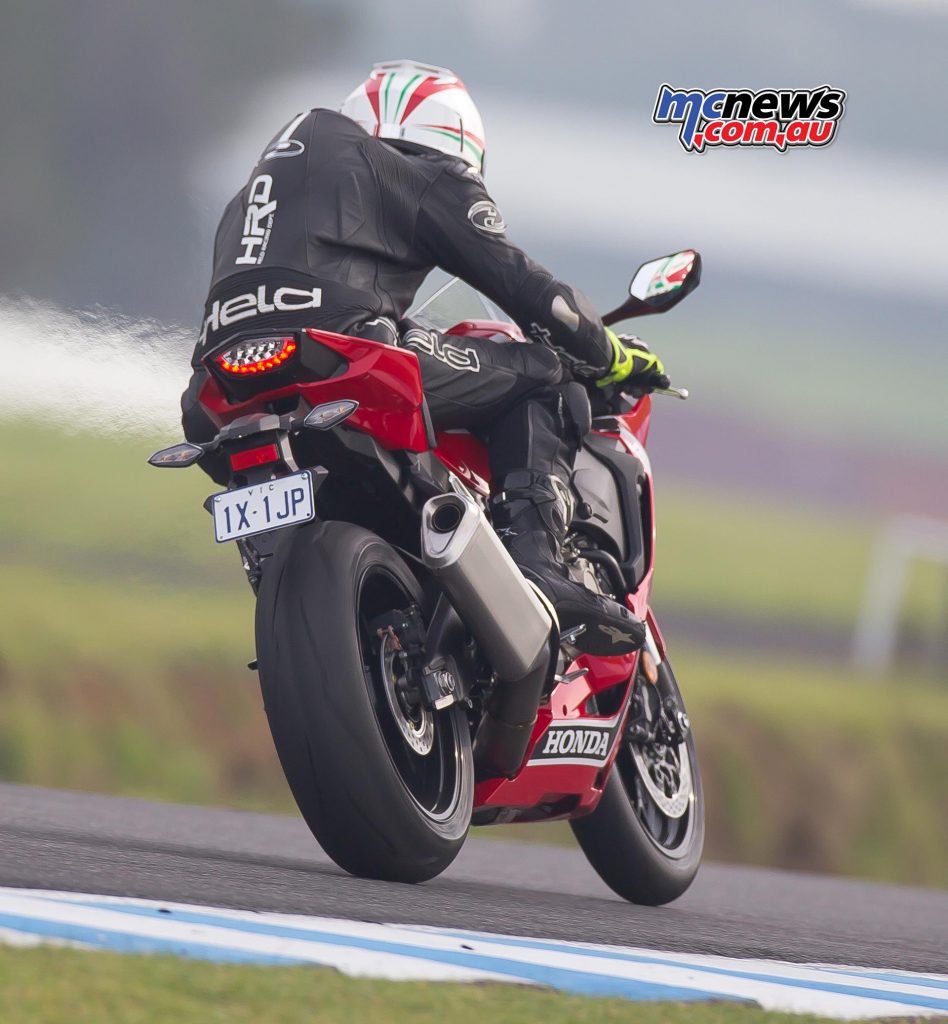
I did try the engine braking control on all three levels, but I didn’t find all that much difference between them. I ended up opting for Level 3, which is minimal engine braking. Through experimentation I found that into tighter turns like Honda , Siberia and MG, it allowed me to roll the bike into the apex a little smoother.
Changing between the three pre-set maps, and the two user programmable maps is easy, intuitive and fast. I programmed one personal favourite and had no problem in switching between the modes out on track. All this information is displayed on the new full colour TFT LCD.
Although the unit is not overly large, it is laid out well and easy to navigate, your eyes quickly finding the desired information. It has a road mode, and a track mode, where a manual lap timer becomes available. I chose not to use the track mode, I had plenty enough to think about already, launching down Gardner straight at 300+km/h!
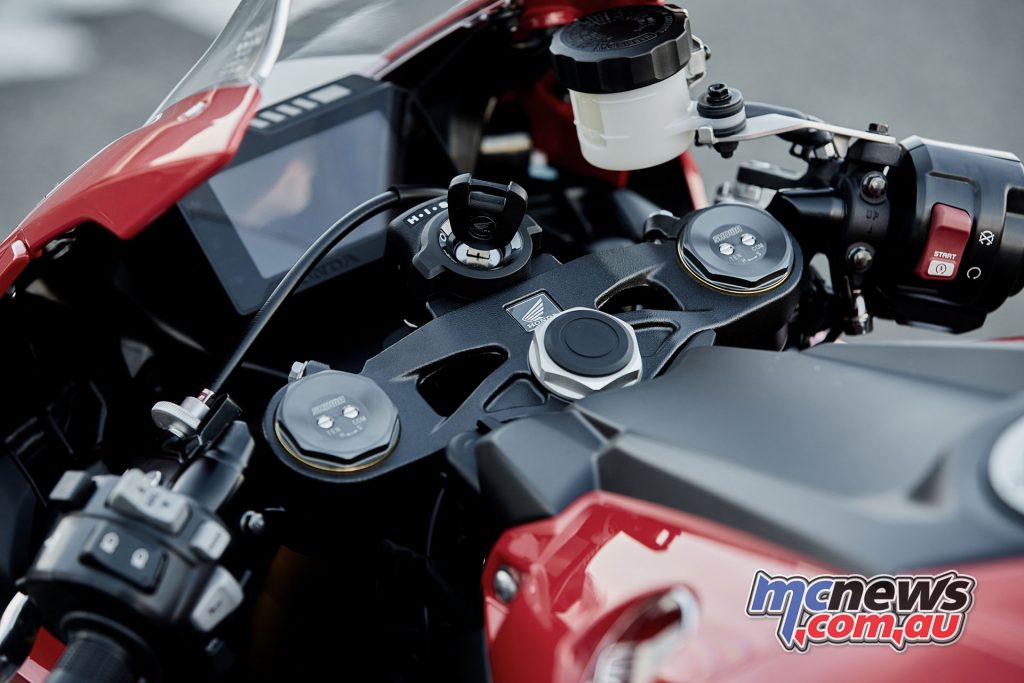
Suspension is again provided by Showa in the form of 43mm BPF inverted telescopic forks and Balance Free Rear Cushion (BFRC) rear shock. Both ends are fully adjustable via spring preload and rebound/compression damping. A testament to how good the bike is out of the crate, is the fact that it wasn’t until lunch time that I wanted to make a few small adjustments with the suspension. We were alreading lapping well below the magic 1m40s barrier before I felt the need to touch a clicker, up until then I had been tuning myself instead!
As the grip subsided on the Pirelli Super Corsas I found that the bike was lacking a little bit of control in the rear shock when it would start to lose traction. Unlike the GSX-R1000, the Honda does have external spring preload adjustment. After a quick chat with my ex-team mate, now current Honda Team Racing guru Paul Free, we opted for one click of preload, which equates to around 1mm, combined with a full turn of compression and rebound.
The control I was chasing was notable almost immediately. I kept this setting for the remainder of the test. I am a 68kg pilot and the spring rate both front and rear suited me just fine. How is that for out of the box standard suspension, on the base model no less, that myself, an ex GP racer, is perfectly happy to cut loose at maximum attack with no feeling that anything is lacking in what is the most crucial aspect of performance when it comes to putting down lap times.
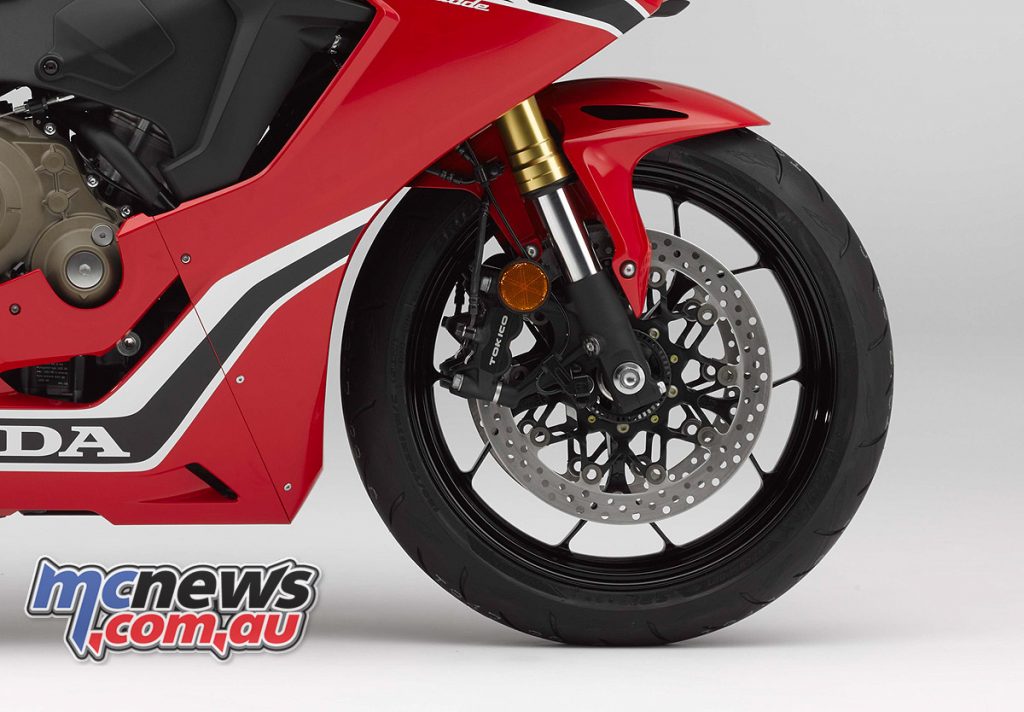
Stopping the Blade are new Tokico four-piston opposed radial-mount brake calipers. Racier style pads have been used for the new model, and I didn’t once feel like I was going to run off the track. The brake feel is good and the lever pressure is nice and firm.
Earlier in the day I was focused on top speed at the end of Gardner straight. After my first four laps I started to edge out my braking marker into turn one. I had seen 295 and 296km/h on the dash board on the previous two laps and I really wanted to crack the 300 mark.
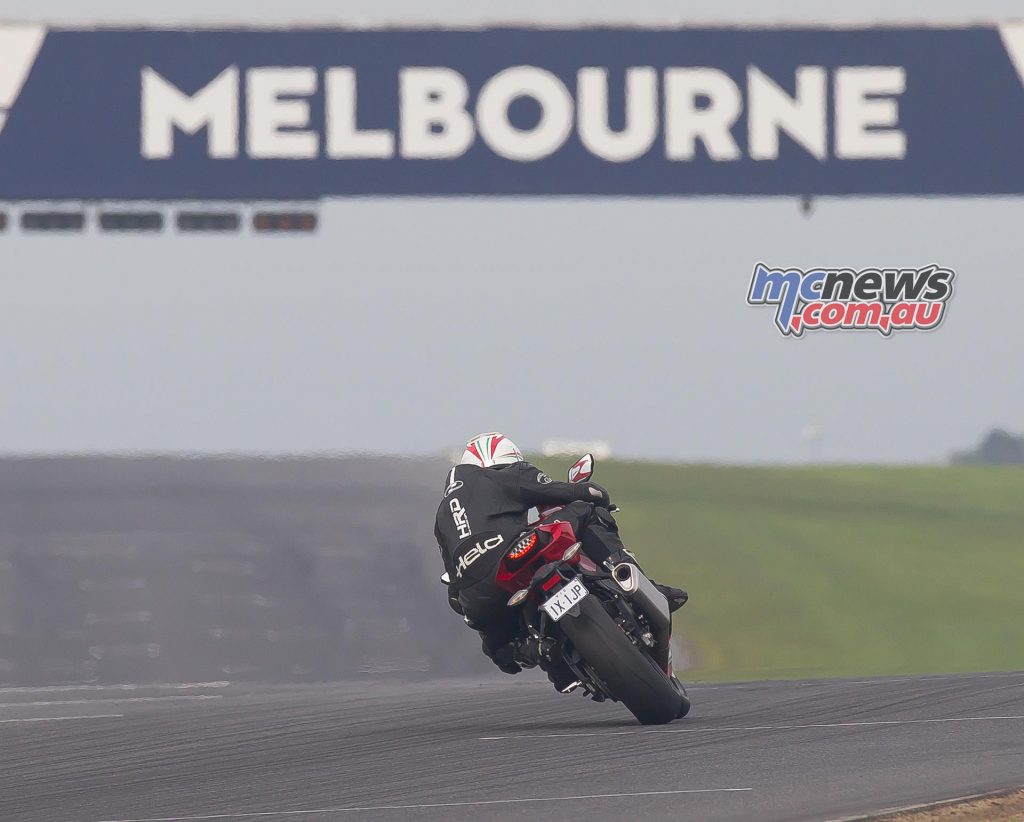
Impressive for a bike that we were essentially running in! So after three more attempts, I couldn’t seem to get it above 299 and I thought I better have a breather and take stock. I wasn’t going to be defeated.
Luckily for me I was talking to the NSW Honda sales representative, John Agius, about my quest for the 300km/h read out. He disappeared briefly only to come back with a big grin on his face and the sad news that I was not going to get there. The dash only reads up to 299!
This was probably a good thing, as otherwise they might have been fishing me out of the Bass Straight… The name Agius is also one you will hear more of over the coming years, John’s son Senna is one of the brightest prospects coming through the dirt track ranks at present, and has just started having a crack on the tarmac.
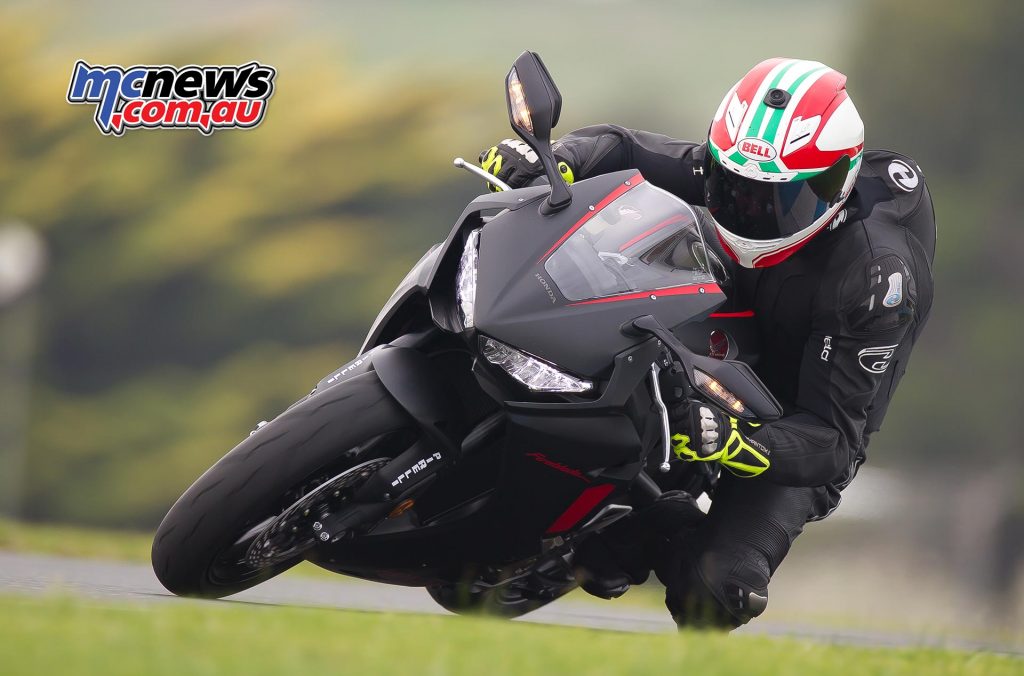
The more laps of that magnificent ribbon of tarmac I completed, the more comfortable and confident I became. I really started to feel at one with the bike. Although my 41-year-old beat up and damaged old body isn’t in the most comfortable of positions on this Blade, the riding experience was sensational.
Just before I finished up for the day I was fortunate enough to have fang on a bike that had been fitted with the optional $650 quick shifter. I personally think that this should be standard on a 2017 sportsbike.
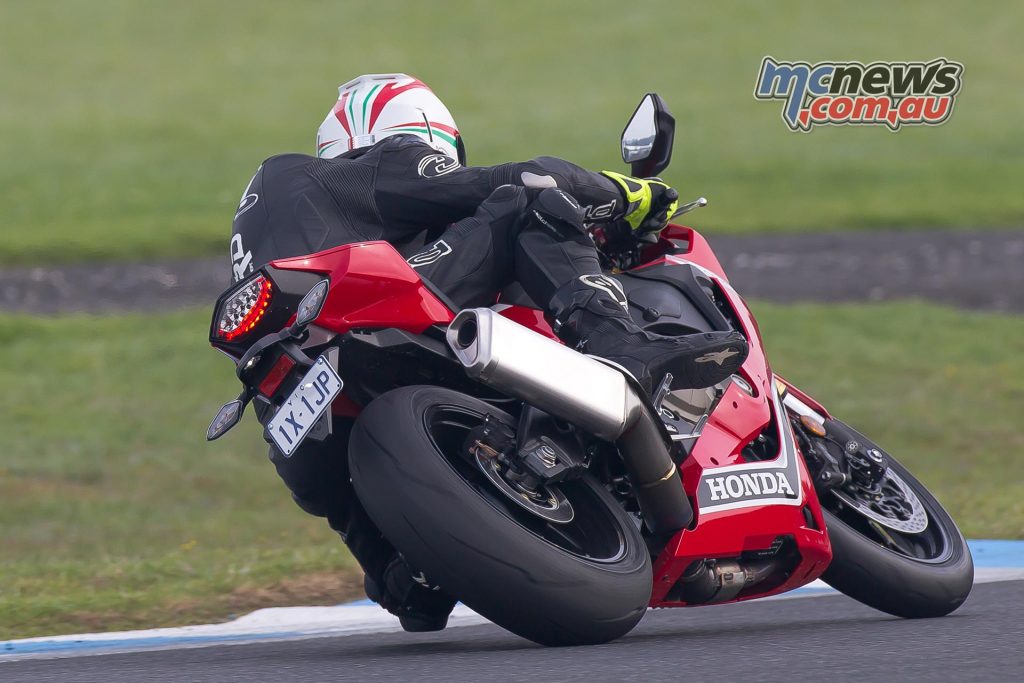
The difference it makes is remarkable, I certainly would be getting one fitted at the dealership before I rode away. Like the new Suzuki GSX-R1000, it works on both the up shift and the downshift. This makes both entering and exiting corners so much smoother.
I personally think that it is nearly as an important rider aid as ABS and traction control, as it allows you to keep more focused on smooth brake operation. It’s days like today that make you appreciate being a motorcyclist. Adrenalin is a disease with no cure!
2017 Honda CBR1000RR Fireblade Summary
Honda has done a great job with the revamped new Fireblade. It now has an electronics package that will hold its own when comparing to the Europeans. and an engine that feels as strong as its Japanese rivals, but maybe falling just shy of the massive horsepower that the BMW and Kawasaki ZX-10R have out of the box.
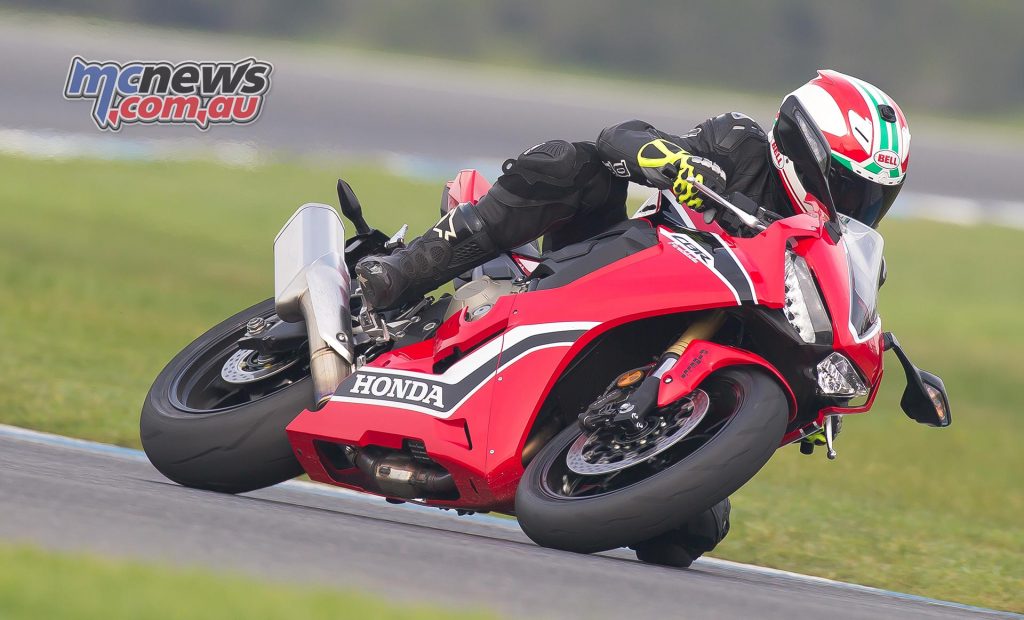
However, the engine makes up for that in its smooth and linear power delivery. The chassis package is spot on, quick adjustments to the rear suspension were easier to make than on the GSX-R1000. The lack of a quick shifter as a standard feature, and the slight glitch in the fly by wire throttle, are the only things that put a small blemish on what is an incredibly well rounded motorcycle.
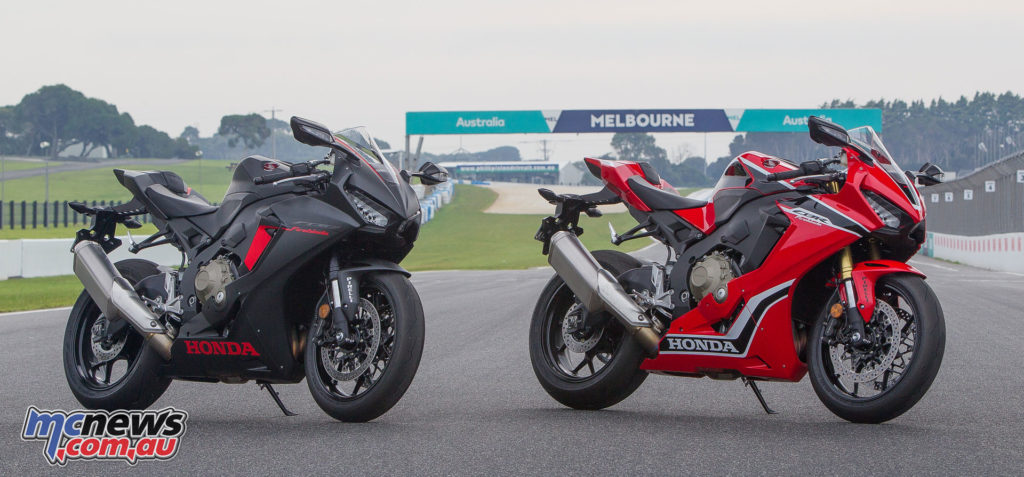
2017 Honda CBR1000RR Fireblade Specifications
- Engine – Liquid-cooled four-stroke 16-valve DOHC inline-four cylinder
- Capacity – 999cc
- Bore x stroke – 76 x 55.1mm
- Compression ratio – 13:1
- Ignition – Computer-controlled digital transistorised with electronic advance
- Carburation – PGM-DSFI electronic fuel injection
- Power – 189hp(141kW)
- Transmission – Six-speed
- Fuel capacity – 16L
- Wet weight – 196kg
- Chassis – Twin-spar aluminium frame
- Front suspension – 43mm Showa Big Piston Front Fork with preload, compression and rebound adjustment, 120mm stroke
- Rear suspension – Unit Pro-Link with gas-charged HMAS damper featuring 10-step preload and stepless compression and rebound
- damping adjustment, Rear Balance Free Rear Cushion
- Front brakes – Dual four-piston radial Tokico calipers, 320mm discs, sintered pads, Dual channel ABS
- Rear brake – Single-piston caliper, 220mm disc, sintered pads, Dual channel ABS
- Front wheel & tyre – 120/70 – 17
- Rear wheel & tyre – 190/50 – 17
- Dimensions
- Wheelbase – 1405mm
- Seat height – 820mm
- Height – 1125mm
- Width – 720mm
- Length – 2065mm
